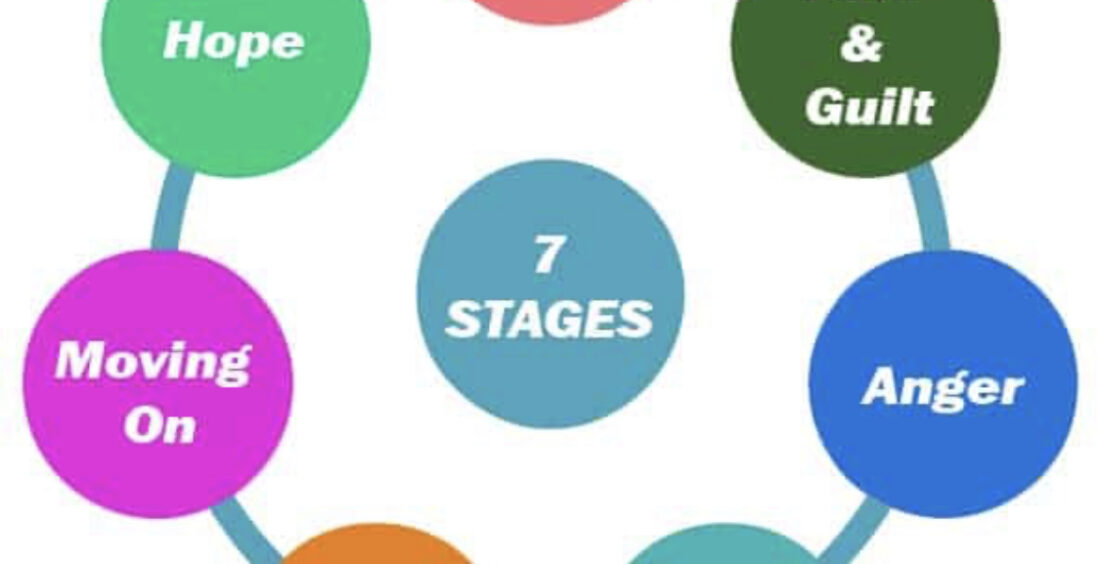Grief is an experience that most everyone encounters at some point in life. It can come in various forms, such as loss of a loved one, loss of a job, change or loss of a relationship, moving to a new location or when a serious illness occurs. Experiencing grief is totally natural. Experiencing unresolved grief can lead to unhealthy behaviors. Learning to identify the stages of grief and ways to cope through each is a great way to begin the journey to healing after a loss or significant life change.
Elizabeth Kübler Ross wrote in her book “On Death and Dying” that grief could be divided into five stages when written in 1969. In the updated copy of this book 2 more stages have been added. Grief is a personal and individual experience. That means you may
Not experience all 7 stages and you may not experience all of the stages in order, you may jump around. It’s important to be educated about this process so you can have a better understanding of where you are to start the healing process.
1. Shock & Denial
You will probably react to learning of the loss with numbed disbelief. You may deny the reality of the loss at some level, in order to avoid the pain. The shock provides emotional protection from being overwhelmed all at once.
2. Pain & Guilt
As the shock wears off, it is replaced with the suffering of unbelievable pain. Although excruciating and almost unbearable, it is important that you experience the pain fully, and not hide it, avoid it or escape from it with alcohol or drugs.
You may have guilty feelings or remorse over things you did or didn’t do with your loved one. Life feels chaotic and scary during this phase.
3. Anger & Bargaining
Frustration gives way to anger, and you may lash out and lay unwarranted blame for the death on someone else. Please try to control this, as permanent damage to your relationships may result. This is not a time for the release of bottled-up emotion. You may rail against fate, questioning “Why me?” You may also try to bargain in vain with the powers that be for a way out of your despair.
4. “Depression”, Reflection, Loneliness
During this time, you finally realize the true magnitude of your loss, and it depresses you. You may isolate yourself on purpose, reflect on things you did with your lost one, and focus on memories of the past. You may sense feelings of emptiness or despair.
5. The Upward Turn
As you start to adjust to life without your dear one, your life becomes a little calmer and more organized. Your physical symptoms lessen, and your “depression” begins to lift slightly.
This is the part of the grieving process that you’ll start to see the light a bit at the end of the tunnel. It’s a middle ground of all the grief symptoms that you’ll go through but it’s one that you can build upon.
6. Reconstruction & Working Through
As you become more functional, your mind starts working again, and you will find yourself seeking realistic solutions to problems posed by life without your loved one. You will start to work on practical and financial problems and reconstructing yourself and your life without him or her.
7. Acceptance & Hope
During this, the last of the seven stages in this grief model, you learn to accept and deal with the reality of your situation. Acceptance does not necessarily mean instant happiness.
Given the pain and turmoil you have experienced, you can never return to the carefree, untroubled YOU that existed before this tragedy. But you will find a way forward. You will start to look forward and actually plan things for the future.
During my grief healing journey I decided to learn about grief and coping with grief by reading books, articles, blogs and watching videos. Gaining an understanding of this model helped to know where my feelings were at the moment they were happening. It started the healing process. Don’t let grief from life’s experiences stop you from living.
Remember to Live Life, Love Life and Have the Day You Deserve even in your grief!


No comments yet.